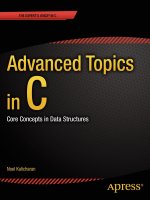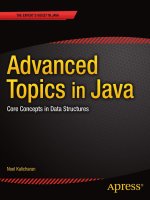CAIA level II advanced core topics in alternative investments 2e sample black donald and hossein
Bạn đang xem bản rút gọn của tài liệu. Xem và tải ngay bản đầy đủ của tài liệu tại đây (7.77 MB, 72 trang )
CAIA
Level II
Founded in 1807, John Wiley & Sons is the oldest independent publishing company in the United States. With offices in North America, Europe, Australia, and
Asia, Wiley is globally committed to developing and marketing print and electronic
products and services for our customers’ professional and personal knowledge and
understanding.
The Wiley Finance series contains books written specifically for finance and
investment professionals as well as sophisticated individual investors and their financial advisors. Book topics range from portfolio management to e-commerce, risk
management, financial engineering, valuation and financial instrument analysis, as
well as much more.
For a list of available titles, visit our Web site at www.WileyFinance.com.
CAIA
Level II
Advanced Core Topics
in Alternative Investments
Second Edition
KEITH H. BLACK
DONALD R. CHAMBERS
HOSSEIN KAZEMI
MARK J.P. ANSON
GALEN BURGHARDT
FRANCOIS-SERGE LHABITANT
JIM LIEW
SUSAN LIEW
GEORGE A. MARTIN
PIERRE-YVES MATHONET
DAVID F. McCARTHY
THOMAS MEYER
EDWARD SZADO
BRIAN WALLS
John Wiley & Sons, Inc.
Copyright
C
2009, 2012 by The CAIA Association. All rights reserved.
Published by John Wiley & Sons, Inc., Hoboken, New Jersey.
Published simultaneously in Canada.
No part of this publication may be reproduced, stored in a retrieval system, or transmitted in any form
or by any means, electronic, mechanical, photocopying, recording, scanning, or otherwise, except as
permitted under Section 107 or 108 of the 1976 United States Copyright Act, without either the prior
written permission of the Publisher, or authorization through payment of the appropriate per-copy fee to
the Copyright Clearance Center, Inc., 222 Rosewood Drive, Danvers, MA 01923, (978) 750-8400, fax
(978) 646-8600, or on the Web at www.copyright.com. Requests to the Publisher for permission should
be addressed to the Permissions Department, John Wiley & Sons, Inc., 111 River Street, Hoboken,
NJ 07030, (201) 748-6011, fax (201) 748-6008, or online at />Limit of Liability/Disclaimer of Warranty: While the publisher and author have used their best efforts in
preparing this book, they make no representations or warranties with respect to the accuracy or
completeness of the contents of this book and specifically disclaim any implied warranties of
merchantability or fitness for a particular purpose. No warranty may be created or extended by sales
representatives or written sales materials. The advice and strategies contained herein may not be suitable
for your situation. You should consult with a professional where appropriate. Neither the publisher nor
author shall be liable for any loss of profit or any other commercial damages, including but not limited
to special, incidental, consequential, or other damages.
For general information on our other products and services or for technical support, please contact our
Customer Care Department within the United States at (800) 762-2974, outside the United States at
(317) 572-3993 or fax (317) 572-4002.
Wiley also publishes its books in a variety of electronic formats. Some content that appears in print may
not be available in electronic books. For more information about Wiley products, visit our Web site at
www.wiley.com.
ISBN 978-1-118-36975-3 (cloth)
ISBN 978-1-118-44727-7 (ebk)
ISBN 978-1-118-44728-4 (ebk)
ISBN 978-1-118-44729-1 (ebk)
Printed in the United States of America
10 9 8 7 6 5 4 3 2 1
Contents
Preface
xv
Acknowledgments
xxi
About the Authors
xxv
CHAPTER 1
Introduction
1.1 Outline of This Book
1.2 Studying for the CAIA Level II Examination
1
1
3
PART ONE
Asset Allocation and Portfolio Management
CHAPTER 2
The Endowment Model
2.1
2.2
2.3
2.4
2.5
Defining Endowments and Foundations
Intergenerational Equity, Inflation, and Spending Challenges
The Endowment Model
Why Might Large Endowments Outperform?
Conclusion
CHAPTER 3
Risk Management for Endowment and Foundation Portfolios
3.1
3.2
3.3
3.4
3.5
Spending Rates and Inflation
Liquidity Issues
Rebalancing and Tactical Asset Allocation
Tail Risk
Conclusion
CHAPTER 4
Pension Fund Portfolio Management
4.1 Defined Benefit Plans
4.2 Governmental Social Security Plans
4.3 Defined Contribution Plans
7
7
10
12
14
19
21
21
24
28
30
32
33
34
43
43
v
vi
CONTENTS
PART TWO
Private Equity
CHAPTER 5
Private Equity Market Landscape
5.1
5.2
5.3
5.4
5.5
5.6
5.7
5.8
Main Strategies
Main Differences between Venture Capital and Buyout
Private Equity Funds as Intermediaries
Private Equity Funds of Funds as Intermediaries
Private Equity Funds of Funds Value-Added
The Relationship Life Cycle between Limited and General Partners
The J-Curve
Conclusion
CHAPTER 6
Private Equity Fund Structure
6.1
6.2
6.3
Key Features
Conflicts of Interest
Finding the Balance
CHAPTER 7
The Investment Process
7.1
7.2
Process Description
Risk Management
CHAPTER 8
Private Equity Portfolio Design
8.1
8.2
8.3
Three Approaches to Private Equity Portfolio Design
Risk-Return Management Approaches
The Risk Profile of Private Equity Assets
CHAPTER 9
Fund Manager Selection Process
9.1
9.2
9.3
9.4
Determination of the Wish List of Fund Characteristics
Deal Sourcing
Due Diligence: Importance and Limitations
Decision and Commitment
CHAPTER 10
Measuring Performance and Benchmarking in the Private Equity World
10.1
10.2
Individual Funds
Portfolio of Funds
CHAPTER 11
Monitoring Private Equity Fund Investments
11.1
11.2
Approach to Monitoring
The Monitoring Objectives
49
49
50
54
56
58
59
62
64
67
69
77
77
79
79
85
89
89
93
99
107
107
109
111
116
117
117
129
135
135
136
vii
Contents
11.3
11.4
Information Gathering in the Monitoring Process
Actions Resulting from Monitoring
CHAPTER 12
Private Equity Fund Valuation
12.1
12.2
12.3
Net Asset Value (NAV)
Internal Rate of Return (IRR)
Economic Value Approach
CHAPTER 13
Private Equity Fund Discount Rates
13.1
13.2
The Capital Asset Pricing Model (CAPM)
Private Equity Fund Betas
CHAPTER 14
The Management of Liquidity
14.1
14.2
14.3
14.4
14.5
14.6
Private Equity Cash Flow Schedules
Sources of Liquidity
Investment Strategies for Undrawn Capital
Cash Flow Projections
Overcommitment
Conclusion
139
142
145
145
147
149
151
151
153
161
161
162
164
165
174
177
PART THREE
Real Assets
CHAPTER 15
Real Estate as an Investment
15.1
15.2
15.3
15.4
Attributes of Real Estate
Asset Allocation
Categories of Real Estate
Return Drivers of Real Estate
CHAPTER 16
Unsmoothing of Appraisal-Based Returns
16.1
16.2
16.3
16.4
Smoothed Pricing
Models of Price and Return Smoothing
Unsmoothing a Price or Return Series
An Illustration of Unsmoothing
CHAPTER 17
Core, Value-Added, and Opportunistic Real Estate
17.1
17.2
17.3
Defining the Three NCREIF Real Estate Styles
Differentiating Styles with Attributes
Purposes of Real Estate Style Analysis
181
181
182
185
189
191
191
194
198
201
207
208
210
210
viii
CONTENTS
17.4
17.5
17.6
Real Estate Style Boxes
Cap Rates and Expected Returns
Developing Risk and Return Expectations with Styles
CHAPTER 18
Real Estate Indices
18.1
18.2
18.3
The Mechanics of Appraisal-Based Indices
Non-Appraisal-Based Indices
Description of Major Real Estate Indices
CHAPTER 19
Public versus Private Real Estate Risks
19.1
19.2
19.3
Market-Based versus Appraisal-Based Returns
Arbitrage, Liquidity, and Segmentation
Public Real Estate Products
CHAPTER 20
Portfolio Allocation within Real Estate
20.1
20.2
20.3
20.4
20.5
20.6
20.7
Income Taxation
Leverage
Agency Relationships
Information Asymmetries
Liquidity and Transaction Costs
Cross-Border Real Estate Investment
Summary and Conclusions
CHAPTER 21
Farmland and Timber Investments
21.1
21.2
21.3
21.4
21.5
21.6
Global Demand for Agricultural Products
Accessing Agricultural Returns
Understanding the Returns to Farmland
Commodity Price Volatility and Its Implication for
Farmland-Based Investment Strategies
Global Investing in Timberland
Key Points and Summary Conclusions
CHAPTER 22
Investing in Intellectual Property
22.1
22.2
22.3
22.4
22.5
Characteristics of Intellectual Property
Film Production and Distribution
Art as an Investment Asset
R&D and Patents
Conclusion
213
214
215
221
221
224
226
231
231
234
244
247
247
250
251
252
253
253
255
257
258
260
264
270
274
277
279
279
281
288
293
298
ix
Contents
PART FOUR
Commodities
CHAPTER 23
Key Concepts in Commodity Market Analysis
23.1
23.2
23.3
23.4
23.5
23.6
Introduction
Real Assets and Financial Assets
The Role of Investors in Commodity Markets
Convenience Yield
Cost of Carry
Theories of Commodity Forward Curves
CHAPTER 24
Role of Commodities in Asset Allocation
24.1
24.2
24.3
24.4
24.5
Introduction
Review of Major Articles and Studies
Sources of Return to Futures-Based Commodity Investment
The Statistical Properties of Commodity Prices
Asset Allocation
CHAPTER 25
Methods of Delivering Commodity Alpha
25.1
25.2
25.3
25.4
25.5
25.6
Introduction
Directional Strategies
Relative Value Strategies
Commodity-Based Equity and Debt Strategies
Fundamental Analysis for Directional and Relative
Value Strategies
Looking Forward
CHAPTER 26
Methods of Delivering Commodity Beta: Indices, Swaps, Notes,
and Hedge Funds
26.1
26.2
26.3
26.4
26.5
26.6
26.7
26.8
26.9
Introduction
Direct Physical Ownership of Commodities
Indirect Ownership of Commodities
Leveraged and Option-Based Structures
Commodity Indices Compared to Securities Indices
Sources of Commodity Index Returns
Issues in Commodity Index Design
Performance Enhancements of Enhanced
Commodity Indices
A Primer on Commodity Index Calculation: Spot, Roll,
Excess, and Total Returns
301
301
302
302
303
304
305
315
315
316
319
320
324
329
329
329
330
338
339
341
343
343
344
344
350
351
352
353
357
359
x
CONTENTS
CHAPTER 27
Macroeconomic Determinants of Commodity Futures Returns
27.1
27.2
27.3
27.4
Commodities as an Inflation Hedge
Commodities and Exchange Rates
Commodities and the Business Cycle
Conclusion
CHAPTER 28
Effective Risk Management Strategies for Commodity Portfolios
28.1
28.2
28.3
28.4
28.5
28.6
28.7
Marking the Net Asset Value
Measuring Event Risks
Stress Testing Using Value at Risk
Measuring Liquidity Risks
Performance Attribution
Mitigating Operational Risks
Conclusion
363
364
371
373
378
379
379
381
382
384
385
386
387
PART FIVE
Hedge Funds and Managed Futures
CHAPTER 29
Structure of the Managed Futures Industry
29.1
29.2
29.3
29.4
29.5
29.6
29.7
29.8
29.9
391
Investing in CTAs and CPOs
Industry Regulation
Benefits of CTAs
Margin Requirements
Understanding Returns
Foreign Currency Exposure
Collateral Income and Segregation Issues
Margin-to-Equity Ratios
Conclusion
391
392
394
395
396
400
400
402
403
CHAPTER 30
Managed Futures: Strategies and Sources of Return
405
30.1
30.2
30.3
30.4
30.5
30.6
Investment Strategies
Economics of Commodity Futures Markets
Efficient Market Hypothesis and Returns to CTAs
Profitability of Momentum-Based and Other Trend-Following
Strategies
Empirical Evidence on Technical Trading Rules
Conclusion
CHAPTER 31
Risk and Performance Analysis in Managed Futures Strategies
31.1
31.2
Risk Measurement
Historical Performance of CTAs
406
408
413
415
423
425
427
427
435
xi
Contents
31.3
31.4
31.5
31.6
31.7
Research on Performance and Benefits of Managed Futures
Benchmarking of CTAs
Alpha-Beta Separation Using Passive Indices
Performance of CTAs during Periods of Financial Stress
Conclusion
CHAPTER 32
Structuring Investments in CTAs
32.1
32.2
32.3
32.4
32.5
32.6
32.7
Sourcing Managers
Issues in Structuring a CTA Investment Program
How Many Managers Should One Choose?
CTA Funds and Multi-CTA Funds
Managed Accounts
Platforms
Comparison of Approaches to Structuring a
CTA Investment
32.8 Quantitative Analysis of Managers
32.9 Investment and Operational Due Diligence Processes
32.10 Cost of Active Management
32.11 Conclusion
CHAPTER 33
Hedge Fund Replication
33.1
33.2
33.3
33.4
33.5
33.6
33.7
33.8
33.9
Introduction
An Overview of Replication Products
Potential Benefits of Replication Products
The Case for Hedge Fund Replication
Unique Benefits of Replication Products
Factor-Based Approach to Replication
Payoff-Distribution Approach
Bottom-Up or Algorithmic Approach
Conclusion
CHAPTER 34
Convertible Arbitrage
34.1
34.2
34.3
34.4
34.5
34.6
34.7
Evolution of the Convertible Arbitrage Strategy
Terminology
Valuation of Convertible Securities
The Greeks
An Arbitrage Situation
Convertible Arbitrage in Practice: Stripping and Swapping
Leverage and Convertible Arbitrage
CHAPTER 35
Global Macro and Currency Strategies
35.1
35.2
Introduction to the Macro Strategies
Directional Currency Trades
439
441
443
446
452
453
453
454
455
458
459
463
463
465
468
470
472
475
475
475
476
477
480
483
488
492
493
497
497
498
500
507
511
515
518
521
521
524
xii
CONTENTS
35.3
35.4
35.5
35.6
The Case of Emerging Markets
Four Models for Currency Trading
A More Complex Trade: Contingent Yield
Curve Steepening
Risk Management and Portfolio Construction
CHAPTER 36
Fundamental Equity Hedge Fund Strategies
36.1
36.2
36.3
36.4
36.5
Variations within Equity Long/Short Funds
Background of the Long/Short Equity Hedge Fund
Mechanics of the Strategy
Managerial Expertise and Sources of Returns
Long/Short Return Attribution
CHAPTER 37
Quantitative Equity Hedge Fund Strategies
37.1
37.2
37.3
37.4
37.5
37.6
Variations of Quantitative Strategies
Background on Quantitative Strategies
Mechanics of Quantitative Strategies
Sources of Returns
A Stylized Quantitative Equity Strategy
The Great Quant Meltdown of August 2007
CHAPTER 38
Funds of Hedge Funds
38.1
38.2
38.3
38.4
38.5
38.6
38.7
38.8
38.9
38.10
38.11
Approaches for Accessing Hedge Funds
Characteristics of Funds of Hedge Funds
Fund of Funds Performance
Fund of Funds Portfolio Construction
Manager Selection
Risk Management
Due Diligence Issues Arising in the Context of Funds
of Funds
Benefits Offered by Funds of Funds
Disadvantages of Funds of Funds
Funds of Funds versus Individual Hedge Funds
Hedge Fund Indices
CHAPTER 39
Regulation and Compliance
39.1
39.2
39.3
39.4
A Succinct History of Hedge Fund Regulation in the
United States
Registration and Regulation in the United States
Various Reporting Requirements for Hedge Funds
The Global Regulatory Environment for Hedge Funds
526
528
535
536
539
539
543
543
547
550
553
553
557
559
563
567
568
573
573
575
578
578
586
586
588
590
592
593
597
603
603
605
612
614
xiii
Contents
CHAPTER 40
Operational Due Diligence
40.1
40.2
Operational Due Diligence
Strategy-Specific Due Diligence
617
618
630
References
645
Index
665
Preface
ince its inception in 2002, the Chartered Alternative Investment Analyst (CAIA)
Association has incorporated state-of-the-art reading materials into its curriculum. This latest curriculum reading represents a milestone in our efforts to continuously improve and update our curriculum. To ensure that the material best
reflects current practices in the area of alternative investments, the CAIA Association
invited a group of leading industry professionals to contribute to the production
of the series, covering core areas of alternative investments: private equity, real
assets, commodities, hedge funds, and managed futures. Similar to other books published by the CAIA Association, this book is grounded in the CAIA program’s Core
Knowledge Outline.
In publishing the books in this series, we are guided by the Association’s mission
to provide its members with a comprehensive knowledge of alternative investments,
to advocate high standards of professional conduct, and to establish the Chartered
Alternative Investment Analyst Charter as the educational gold standard for the
alternative investment industry.
S
TEN YEARS OF CAIA AND ALTERNATIVE INVESTMENTS
The quality, rigor, and relevance of this series derive from the ideals on which the
CAIA Association is based. After its founding in 2002, the first Level I examination
was offered in February 2003, with the first Level II examination taking place in
October 2003. I was privileged to be among the first class of 43 candidates who
passed the Level I and Level II exams, met the other requirements of membership, and
were invited to join the CAIA Association. Many of these founding members were
instrumental in establishing the CAIA Charter as the global mark of excellence in
alternative investment education. After just 10 years, we now have more than 5,700
members in 75 countries. Those who become members of the CAIA Association have
the opportunity to network with other CAIA members, including attending events
sponsored by CAIA’s 15 chapters, located in financial centers worldwide.
The growth of CAIA, from 43 members to more than 5,700 members in 10 years,
closely parallels the growth of the alternative investments industry. Preqin estimates
that private equity assets in December 2002 were $767 billion, while closed-end
private real estate assets under management (AUM) totaled just $81 billion. At the
same time, Hedge Fund Research estimates that the hedge fund industry managed
$625.5 billion. By 2011, assets across all alternative investment types had exploded,
with hedge funds managing over $2,000 billion, private equity controlling nearly
$3,000 billion, and private real estate investing over $500 billion. (See Exhibits
P.1 and P.2). In 2003, infrastructure and commodity assets likely totaled less than
$20 billion. While these asset classes were nascent in 2003, Preqin now estimates
xv
xvi
PREFACE
3,500
3,000
2,500
2,000
1,500
1,413
1,937
1,204
1,783
1,265
896
1,000
500
0
675
418
298
374
360
465
554
1,067
994
981
405
409
806
1,075
407
563
1,011
377
Dec.
2000
Dec.
2001
Dec.
2002
Dec.
2003
Dec.
2004
Dec.
2005
Dec.
2006
Dec.
2007
Dec.
2008
Dec.
2009
Dec.
2010
Jun.
2011
Dry Powder ($bn)
Unrealized Value ($bn)
EXHIBIT P.1
Growth of Private Equity Assets under Management (AUM) (in billions of
dollars)
Source: Preqin Ltd.
infrastructure assets at $174 billion, while Barclays estimates commodity assets at
over $420 billion. In the past 10 years, entire asset classes have been created, with the
first commodity exchange-traded fund being offered in November 2004; currently,
commodity exchange-traded products hold over $200 billion in assets. Dry powder
is the amount of assets controlled by, or committed to, closed-end funds that has
not yet been invested by the fund manager. Larger amounts of dry powder indicate
the amount of cash available to invest in the underlying assets, which leads some
market participants to predict higher deal volume and asset valuation in the coming
quarters.
THE HISTORY OF CAIA
The CAIA Association was introduced to the investment community in 2002 by Florence Lombard, then Chief Executive Director of the Alternative Investment Management Association (AIMA), and Dr. Thomas Schneeweis, Director of the Center
600
500
400
300
257
241
228
173
177
185
319
359
158
151
156
200
98
100
0
40
41
61
40
72
57
99
136
Dec. 2002 Dec. 2003 Dec. 2004 Dec. 2005 Dec. 2006 Dec. 2007 Dec. 2008 Dec. 2009 Dec. 2010 Jun. 2011
Dry Powder ($bn)
Unrealized Value ($bn)
EXHIBIT P.2 Growth of Closed-End Private Real Estate Assets under Management (AUM)
(in billions of dollars)
Source: Preqin Ltd.
xvii
Preface
6,000
5,000
4,000
3,000
2,000
1,000
N
ov
.
M 200
ay 3
N 200
ov 4
.
M 200
ay 4
N 200
ov 5
.
M 200
ay 5
N 200
ov 6
.
M 200
ay 6
N 200
ov 7
.
M 200
ay 7
N 200
ov 8
.
M 200
ay 8
N 20
ov 09
.
M 200
ay 9
N 201
ov 0
.
M 201
ay 0
2
N 01
ov 1
.2
01
1
0
EXHIBIT P.3 Growth of CAIA Membership
Source: CAIA Association.
for International Securities and Derivatives Markets (CISDM). Ten years ago, together with a core group of academic and industry experts determined to fill an
unmet need for a standard of education in this bourgeoning sector, they launched
the CAIA Charter.
Like the sector of the industry it covers, the CAIA Association has grown rapidly.
In 2008, the New York Society of Security Analysts recognized CAIA as the fastestgrowing financial credential, and in the past three years alone, membership has
more than doubled to more than 5,700. Fostered by a dedicated chapter relations
team, the number of CAIA chapters has tripled to 15 from the first five chapters
established in 2005; CAIA chapters now provide a platform for educational, career,
and networking activities for thousands of alternative investments professionals in
the world’s major financial centers. CAIA now has six offices globally.
As the Association has grown, its program has evolved and advanced. In 2009,
CAIA introduced the first editions of the most complete, authoritative desktop reference volumes on alternative investments ever created: CAIA Level I: An Introduction
to Core Topics in Alternative Investments and CAIA Level II: Advanced Core Topics
in Alternative Investments, written and edited exclusively by leading practitioners
and academics. Now, in 2012, CAIA Association has published second editions of
these volumes to keep pace with the latest strategies and information. Along with
CAIA Level II: Core and Integrated Topics (which is revised annually to contain the
most advanced material) and the Standards of Practice Handbook published by CFA
Institute, these volumes round out a complete education in alternative investments
for any finance professional.
CAIA has also continually provided ongoing educational resources to serve its
growing member and candidate base. The suite of offerings includes the Journal of
Alternative Investments, the official publication of the CAIA Association, and Alternative Investment Analyst Review, a digital research digest designed to make keeping
abreast of the latest research easier. It also includes the member Self-Evaluation Tool
and Member Library, designed to work together to help members stay current on
the latest knowledge in alternative investments; multimedia content; educational and
conference discounts; and more.
xviii
PREFACE
The Association formalized its commitment to advancing the alternative investment industry now and in the future by establishing the CAIA Foundation in 2011.
The Foundation partners with sponsors to fund research and scholarships, raising
the standard of knowledge and the talent pool in the alternative investment industry
for the ultimate benefit of the investor.
BENEFITS OF THE CAIA PROGRAM
CAIA has become the leading-edge alternative investment credential and the unchallenged leading provider of education in alternative investments. Although the
establishment of the CAIA Association was largely due to the efforts of professionals
in the hedge fund and managed futures space, these founders correctly identified a
void in the wider understanding of alternative investments as a whole. From the
beginning, the CAIA curriculum has also covered private equity, commodities, and
real assets, always with an eye toward shifts in the industry. Today, several hundred
CAIA members identify their main area of expertise as real estate or private equity; several hundred more are from family offices, pension funds, endowments, and
sovereign wealth funds that allocate across multiple classes within the alternative
investment industry. Investment professionals in any asset class, such as real estate
professionals, can benefit from a broad-based education in alternative investments,
as it is important to see the big picture of institutional portfolios. An understanding
of the investment goals and practices of institutional investors, including pensions,
sovereign wealth funds, endowments, and foundations, is important for both institutional investors and managers of alternative investment products.
To accomplish this comprehensively, we have fully developed curriculum subcommittees that represent each area of coverage within the curriculum. All of these
alternative investment areas share many distinct features, such as the relative freedom on the part of investment managers to act in the best interests of their investors,
alignment of interests between investors and management, relative illiquidity of positions for some investment products, and deviations from some of the underpinning
assumptions of modern portfolio theory. These characteristics necessitate conceptual and actual modifications to the standard investment performance analysis and
decision-making paradigms.
Readers will find the publications in our series beneficial, whether from the
standpoint of allocating to new asset classes and strategies in order to gain broader
diversification or from the standpoint of a specialist needing to better understand the
competing options available to sophisticated investors globally. In either case, readers
will be better equipped to serve their clients’ needs. The series has been designed
to make studying more efficient relative to our past curriculum. Importantly, it is
more relevant, having been written under the direction of the CAIA Association
with the input and efforts of many practicing and eminent alternative investment
professionals, as reflected in each publication’s acknowledgments section.
STUDYING FOR THE CAIA EXAMS
“Foundations of the CAIA Curriculum” is an assessment tool for determining a candidate’s readiness to enter the CAIA program. These foundational materials cover
Preface
xix
the quantitative analytics commonly associated with traditional assets, as well as a
blend of practical and theoretical knowledge relating to both traditional and alternative investments.
The first book in our series, CAIA Level I: An Introduction to Core Topics in
Alternative Investments, is a twice-revised edition of Mark Anson’s Handbook of
Alternative Assets. The CAIA Level I required readings are contained in this one text,
supplemented only by the CFA Institute’s Standards of Practice Handbook. Readers
should be aware, however, that the Foundations program is important and that Level
I candidates are assumed to have mastered all of the content in the Foundations guide
in advance of taking the Level I exam.
The second book in our series, CAIA Level II: Advanced Core Topics in Alternative Investments, also represents a significant advancement in the coverage of
our curriculum. The tools candidates develop in Level I of the CAIA program are
applied in the Level II curriculum, which both integrates alternative investments into
investor portfolios and presents risk management across asset classes. We believe
this new model of curriculum development accurately reflects the skill set required
of industry practitioners.
The third volume in this series is titled CAIA Level II: Core and Integrated
Topics. It is updated annually and designed to address topics that cut across all areas
of alternative investments, such as asset allocation and risk-management techniques,
as well as new developments in the alternative investment research space and in
the industry itself. This book is more frequently revised, which allows the Level II
curriculum to rapidly adapt to new research trends in alternative investments as
covered in academic and practitioner journals.
Finally, we will continue to update both the CAIA Level I Study Guide and
the CAIA Level II Study Guide every six months (each exam cycle). These guides,
available for free download at , outline all of the readings and corresponding learning objectives (LOs) that candidates are responsible for meeting. They
also contain important information for candidates regarding the use of LOs, testing
policies, topic weightings, where to find and report errata, and much more. The
entire exam process is outlined in the CAIA Candidate Handbook and is available
at />I believe you will find this series to be the most comprehensive, rigorous, and
globally relevant source of educational material available within the field of alternative investments.
It is my sincere wish that this volume contributes to the continuing growth of
the alternative investments industry and, in particular, to the career growth of CAIA
members and CAIA candidates.
KEITH H. BLACK, PhD, CFA, CAIA
Associate Director of Curriculum
CAIA Association
September 2012
Acknowledgments
e would like to thank the many individuals who played important roles in
producing this book. Each section of this volume was developed by a set of
main authors; however, several others were instrumental in bringing this project
to its completion. Hossein Kazemi; Nelson Lacey; Donald R. Chambers, CAIA;
and Kristaps Licis contributed greatly by providing and revising content in all
sections, assisting with the development of the initial section outlines, which are
based on the CAIA Core Knowledge Outline (CKO), and reviewing several section
drafts. The following people were instrumental in bringing this project to its completion: Aaron Cunningham, CAIA; Brad Case, CAIA; Eliot Geller, CAIA; Hilary
Till; James Bachman, CAIA; James Burron, CAIA; Jason Campbell, CAIA; Klaus
Springer, CAIA; Robert Murphy, CAIA; Sam Gallo, CAIA; Sue Bannon, CAIA;
Robert O’Donnell, CAIA; Jean Michaud; Christine Gaelzer; Thomas Schneeweis; and
Timothy Peterson, CAIA.
Keith Black, CAIA, is the author of the first section on asset allocation and
portfolio management. The main authors of the private equity section are Pierre-Yves
Mathonet and Thomas Meyer. The main author of the real estate section is Donald
R. Chambers, CAIA, with contributions from Mark Anson, CAIA. Chapters on
timberland, farmland, and intellectual property were contributed by George Martin.
The main author of the commodities section is Ed Szado, while chapters were also
contributed by Moazzam Khoja, Zeno Adams, Roland Fuss, and Dieter Kaiser.
Chapters on hedge funds and managed futures were authored by Hossein Kazemi,
David McCarthy, Jim Liew, Susan Liew, and Keith Black, CAIA.
Finally, the second edition contains substantial content from the first edition of
the book. Additional authors from the first edition include Urbi Garay, Ernest Jaffarian, Melissa Donohue, Richard Spurgin, Francois Lhabitant, and Simon Stevenson.
Importantly, we owe great thanks to Florence Lombard, Chief Executive Officer
of the CAIA Association, and our committee members:
W
Curriculum Advisory Council
Mark Baumgartner
Jaeson Dubrovay, CAIA
David McCarthy
Armand van Houten, CAIA
Garry Crowder
James Tomeo
Daniel Celeghin
Angelo A. Calvello
xxi
xxii
ACKNOWLEDGMENTS
Hedge Funds and Fund of Hedge Funds Committee
Solomon Tadesse
Jaeson Dubrovay, CAIA
Daniel Celeghin
Mark Hutchinson
Mark Wiltshire, CAIA
Real Assets Committee
Stephane Amara, CAIA
George A. Martin
Andreas Calianos
Tom Johnson, CAIA
Asif Hussain, CAIA
Commodities and CTAs Committee
Hamlin Lovell, CAIA
David McCarthy
Hilary Till
Joelle Miffre
Richard Spurgin
Private Equity Committee
Pierre-Yves Mathonet
Thomas Meyer
James Bachman, CAIA
Erik Benrud, CAIA
Gitanjali M. Swamy
Due Diligence and Regulation Committee
Jaeson Dubrovay, CAIA
Armand van Houten, CAIA
Tom Kehoe, CAIA
Hamlin Lovell, CAIA
Christopher Schelling, CAIA
Mark Wiltshire, CAIA
Asset Allocation, Risk Management, and Wealth Management Committee
Solomon Tadesse
Joelle Miffre
James T. Gillies, CAIA
Pierre Laroche
Acknowledgments
Structured Products Committee
Jon Rotolo
Samson Koo
CAIA Curriculum Group
Hossein Kazemi, PhD, CFA, Program Director
Donald Chambers, PhD, CAIA, Associate Director and Level I Manager
Keith Black, PhD, CFA, CAIA, Associate Director and Level II Manager
Jeanne Miller, Project Manager
Andrew Tetreault, Curriculum Assistant
Samantha Dodge, Editorial Consultant
Jamie Thaman, Editorial Consultant
xxiii









